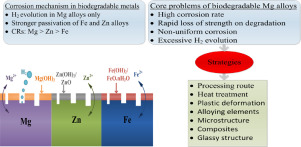当前位置:
X-MOL 学术
›
Acta Biomater.
›
论文详情
Our official English website, www.x-mol.net, welcomes your
feedback! (Note: you will need to create a separate account there.)
Prospects and strategies for magnesium alloys as biodegradable implants from crystalline to bulk metallic glasses and composites-A review.
Acta Biomaterialia ( IF 9.4 ) Pub Date : 2019-12-24 , DOI: 10.1016/j.actbio.2019.12.023 Faisal Kiani 1 , Cuie Wen 1 , Yuncang Li 1
Acta Biomaterialia ( IF 9.4 ) Pub Date : 2019-12-24 , DOI: 10.1016/j.actbio.2019.12.023 Faisal Kiani 1 , Cuie Wen 1 , Yuncang Li 1
Affiliation

|
As a biodegradable metal (BM), alloys of magnesium (Mg) offer great potential as an alternative to the permanent metallic implants currently being used for fracture repairs and tissue-healing processes. These alloys exhibit superior biocompatibility and appropriate mechanical strength and dissolution behavior in the physiological environment, essential prerequisites for a BM. However, rapid and generally non-uniform corrosion has been the major drawback of Mg alloys. Abrupt deterioration in mechanical strength is experienced due to the inhomogeneous corrosion, which is also considered detrimental to the surface passivation process. This review has analyzed a variety of strategies that can be adopted to address the core challenges with Mg alloy biomaterials. In addition, the review provides fundamental understanding of the mechanisms associated with these challenging problems, including discussion of crystalline and bulk metallic glasses (BMGs) and composites. Comparison among the properties and mechanisms observed in other metal alloy systems, including zinc (Zn) and iron (Fe) alloys and prominent BMGs, are also presented for analysis in order to provide new approaches to resolving the critical issues of Mg alloys. STATEMENT OF SIGNIFICANCE: The effects of alloying elements, microstructure, heat treatment and deformation on the mechanical and corrosion properties of biodegradable metals such as Mg-based alloys and bulk metal glasses (BMGs) are identified. Theoretical models and experimental findings are comprehensively analyzed to corroborate the actual corrosion and deformation mechanisms observed in biodegradable metals (BMs). This work also provides an in-depth comparison of mechanical and corrosion properties among the prominent biodegradable metal alloy systems, illustrating a clear outlook on their potentials. The proposed strategies to address the current challenges in BMs are substantiated with fundamental theories and experimental evidence.
中文翻译:

镁合金作为可生物降解植入物的前景和策略,从晶体玻璃到块状金属玻璃和复合材料-综述。
作为一种可生物降解的金属(BM),镁合金(Mg)具有巨大的潜力,可以替代目前用于骨折修复和组织愈合过程的永久性金属植入物。这些合金在生理环境中表现出卓越的生物相容性以及适当的机械强度和溶解性能,这是BM的基本前提。但是,快速且通常不均匀的腐蚀已成为Mg合金的主要缺点。由于不均匀腐蚀,导致机械强度突然下降,这也被认为不利于表面钝化过程。这篇综述分析了可用于解决镁合金生物材料面临的核心挑战的各种策略。此外,这篇综述提供了与这些挑战性问题相关的机制的基本理解,包括对晶体和块状金属玻璃(BMG)以及复合材料的讨论。还对其他金属合金系统(包括锌(Zn)和铁(Fe)合金以及著名的BMG)中观察到的性能和机理进行了比较,以进行分析,以提供解决Mg合金关键问题的新方法。意义声明:确定了合金元素,微观结构,热处理和变形对可生物降解金属(例如,镁基合金和大块金属玻璃(BMG))的机械和腐蚀性能的影响。对理论模型和实验结果进行了全面分析,以证实在可生物降解金属(BMs)中观察到的实际腐蚀和变形机制。这项工作还对著名的可生物降解金属合金系统之间的机械性能和腐蚀性能进行了深入比较,从而清楚地展示了它们的潜力。提出的应对BM当前挑战的策略以基本理论和实验证据得到证实。
更新日期:2019-12-25
中文翻译:

镁合金作为可生物降解植入物的前景和策略,从晶体玻璃到块状金属玻璃和复合材料-综述。
作为一种可生物降解的金属(BM),镁合金(Mg)具有巨大的潜力,可以替代目前用于骨折修复和组织愈合过程的永久性金属植入物。这些合金在生理环境中表现出卓越的生物相容性以及适当的机械强度和溶解性能,这是BM的基本前提。但是,快速且通常不均匀的腐蚀已成为Mg合金的主要缺点。由于不均匀腐蚀,导致机械强度突然下降,这也被认为不利于表面钝化过程。这篇综述分析了可用于解决镁合金生物材料面临的核心挑战的各种策略。此外,这篇综述提供了与这些挑战性问题相关的机制的基本理解,包括对晶体和块状金属玻璃(BMG)以及复合材料的讨论。还对其他金属合金系统(包括锌(Zn)和铁(Fe)合金以及著名的BMG)中观察到的性能和机理进行了比较,以进行分析,以提供解决Mg合金关键问题的新方法。意义声明:确定了合金元素,微观结构,热处理和变形对可生物降解金属(例如,镁基合金和大块金属玻璃(BMG))的机械和腐蚀性能的影响。对理论模型和实验结果进行了全面分析,以证实在可生物降解金属(BMs)中观察到的实际腐蚀和变形机制。这项工作还对著名的可生物降解金属合金系统之间的机械性能和腐蚀性能进行了深入比较,从而清楚地展示了它们的潜力。提出的应对BM当前挑战的策略以基本理论和实验证据得到证实。











































 京公网安备 11010802027423号
京公网安备 11010802027423号